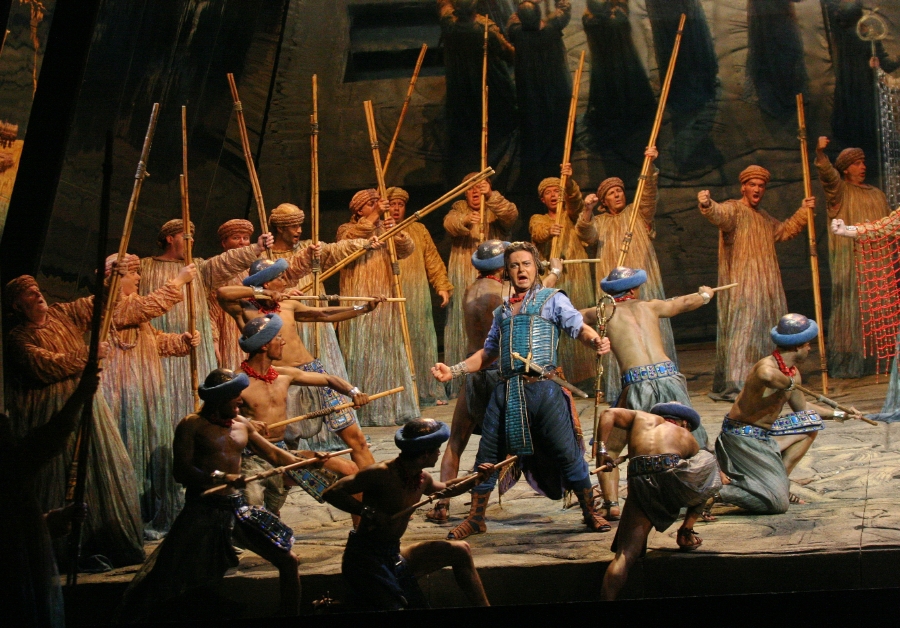Maestro Giuseppe Verdi’s opera “Aida” still with its birth conquered the world of opera. With “Aida” was opened Arena di Verona – the largest open air stage in the world. It continues to be an exciting experience also today on all open air stages. Not only because it is the most splendid stage spectacle, but because the music of the Italian maestro conquers the hearts with the love drama and the beautiful catchy melodies, with the large-scale and lyric scenes.
The height of the “grand opera” is a product of the great challenges of the transforming 19. century, when the world was dynamically nearing the new century.
Maestro Giuseppe Verdi’s masterpiece, the opera “Aida”, was born at the same time when he created his “Requiem”. This was the period between the 1860’s and the 1870’s, when he was at the height of his fame, but also when he fell into a deep crisis. Not only because he suffered the loss of his close friends: the librettist Francesco Piave, Rossini’s death and soon after – the decease of the poet Manzoni, but also because he was disappointed at the recent political events. The “Maestro of Italian revolution”, as Italy calls also today its Maestro, was feeling sore about the government’s treason against the national ideals: something, which was charging with energy his life and work.
This was also the time of the industrialisation, great discoveries and large projects on the way. One of them was the construction of the Suez Canal. For the celebrations on the occasion of its opening in 1868, the Egyptian government turned to Verdi with the request to compose an opera with Egyptian plot. With the work of the maestro had to be opened the Cairo Theatre. All the time big projects, which meant also joining to European culture. In the beginning, Verdi refused the order, but when he got acquainted with the scenario of “Aida” by the well-known French Egyptologist Auguste Mariette he became enthusiastic about it and decided to accept the invitation. Mariette worked out his plot after the legend from the deciphered by him papyrus from the age of the long lasting fights of the pharaohs against Nubia (Ethiopia). The sets and the costumes were also made after Mariette’s paintings. The text in prose was written by the French librettist C. du Locle with whom Verdi had already worked together for the libretto of “Don Carlo”, and the Italian libretto in verses was written by the poet Antonio Ghislanzoni. This was a new challenge for Verdi. With strong interest he studied the history of Egyptian art; he took part actively `also in the work on the plot.
The Bulgarian opera theatre has always had its great performers for the opera hit “Aida”. Our audience has applauded the unforgettable Radamès of Dimitar Uzunov and Nikola Nikolov, Amneris of Elena Nicolai, Aida of Julia Wiener, of Anna Tomowa-Sintow, of the different generations of singers. I shall remind that in 2013, when the world was celebrating the 200th Anniversary of both opera masters: Giuseppe Verdi and Richard Wagner, the Sofia Opera opened its season with the celebration flourish of trumpets of the opera “Aida”, continuing with the series of spectacles of the Italian maestro. Then was also the premiere of Wagner’s “Götterdämmerung”, followed by the presentation of the whole cycle “Der Ring des Nibelungen”.
This way our first opera theatre joined the celebrations on the occasion of both Jubilees with its own tint and contribution. A big challenge, a response of which had few theatres in the world. The titles of both revolutionaries from the Romantic period were also a special rediscovery of their messages to our time, a glance towards today’s fight for change and humanity.
Actually, the premiere of Verdi’s masterpiece “Aida” has set the beginning of the collaboration of the Sofia Opera with Verdi’s largest open air stage – Arena di Verona, which in 2013 celebrated its 100th Anniversary.
I had the chance to experience on this magical stage the spectacle of “Nabucco” in 2000, the spectacle with which Ghena Dimitrova said farewell to the stage on which she was discovered, where the legend about “the voice of Arena di Verona” is alive also today. This was also my first meeting with the widely discussed director Hugo de Ana. I was expecting with interest his director’s interpretation of “Aida”.
Hugo de Ana is well-known as an artist with original approach to modern opera theatre. Director, set designer and costume designer, he realizes his ideas by holding namely these key elements in the making of theatre. Having graduated the Arts School in his native Buenos Aires, he is professor in Visual arts and costume design for TV and cinema: something which is visible in his work, with his special flavour of an identity, different from the European one, carrying rich layers of the different culture.
This fairy-tale production with intriguing vision of the Argentine director, with the sets of Arena di Verona, the costumes of the Sofia Opera, with the wonderful chorus, ballet and orchestra, and with the colour of the excellent soloists will be brought to life on the stage of the National Opera and Ballet in three spectacles on 8, 9 and 10 May 2015. On the three spectacles we shall have a meeting with three different Aidas – Gabriela Georgieva, Bayasgalan Dashnyam and Radostina Nikolaeva, in the role of Amneris – Gergana Rusekova and Tsveta Sarambelieva, and in the role of Radamès – Martin Iliev and Kostadin Andreev.
On the wings of maestro Verdi’s music, with Hugo de Ana’s imagination and the excellent soloists, chorus, orchestra and ballet you will have the luck to immerge into an exciting experience of great emotions. A temptation for anyone who desires to wake up in himself the feeling of great passions, love and jealousy, the magic of the world of opera, which is charging us with hope and beauty.
Give yourself this present for good mood in the advancing spring!
Dr. MAGDALENA MANOLOVA
